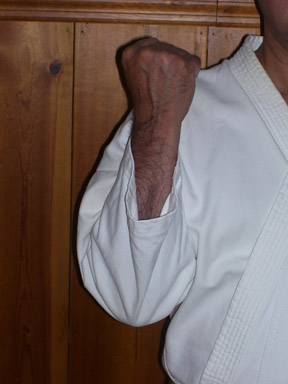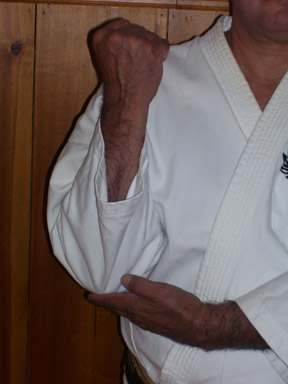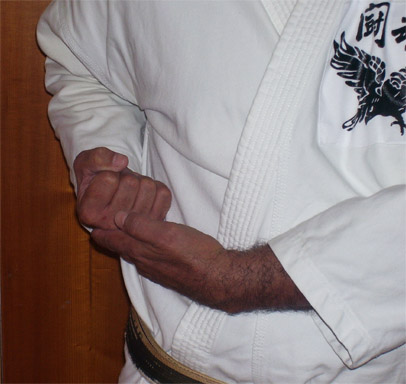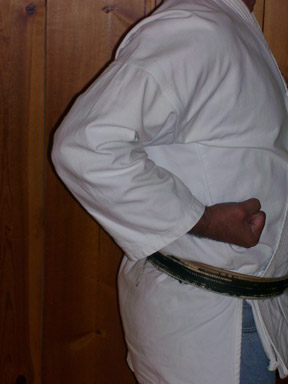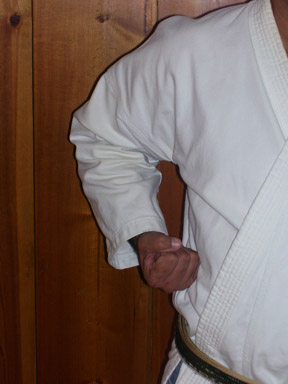Hikite
by yonezato Goyo
Hikite means “pulling hand” (hiki=pulling, te=hand) and refers to the hand held at the side of the body when punching. When one fist goes out, the other fist retracts and arrives at the side of the body, palm up. There are several questions that arise from this; Where exactly should it arrive? Why there? What should it look like?
There is an easy process to discover where hikite should be positioned on the side of the body. This is a fail-safe method that works for everyone regardless of body size.
First you make a fist and bend your arm up with your elbow next to your body. Make sure the palm is facing your body.
Next you pull your bent arm in tight and place your other hand, open palm, under the elbow.
Next, you place your closed fist upon the open hand at your side. This is where your hikite should always land. If you wiggle your hand back and forth you will notice the knuckle on the little finger is at the bottom “floating” rib. This is a good checkpoint. If the little finger is not at the floating rib, try again.
To finish correct positioning, pull your fist back until it is in the middle of your body. Now place your other hand directly opposite on the other side of your body. Check for the floating rib.
Precautions include making sure the elbow is not sticking out (affectionately known as “chicken-wings”). The elbow should be aligned directly behind the fist.
Why do we position hikite there? Why not higher so we can get a more straight-line tsuki? The answer lies in musculature.
Try this yourself…Position your hand as high up on your side as you can, for a more straight-in trajectory, and punch. Notice the tricep muscles in the back of your arm does most of the work, supported by the shoulder muscles (causing the shoulder to rise and tense). Now, punch from the floating rib position and note which muscles are in play. From the floating rib position the bicep muscle in front of the arm initiates the action. The bicep is a larger muscle than the tricep and can create more power. The shoulder muscle is used less and does not automatically tense and rise.
When the fist is at the side of the body, it should be turned over so the palm is flat and facing up. Avoid any rotation. All rotation should occur at the end of the punch, not at the beginning of the punch.
Try this yourself…Position your hand as high up on your side as you can, for a more straight-in trajectory, and punch. Notice the tricep muscles in the back of your arm does most of the work, supported by the shoulder muscles (causing the shoulder to rise and tense). Now, punch from the floating rib position and note which muscles are in play. From the floating rib position the bicep muscle in front of the arm initiates the action. The bicep is a larger muscle than the tricep and can create more power. The shoulder muscle is used less and does not automatically tense and rise.
When the fist is at the side of the body, it should be turned over so the palm is flat and facing up. Avoid any rotation. All rotation should occur at the end of the punch, not at the beginning of the punch.
Copyright © Genwakai America, Ltd. All rights reserved.

